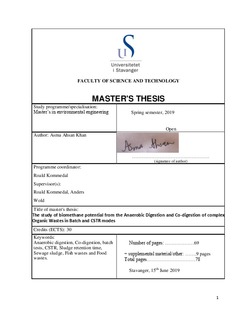| dc.description.abstract | The world is now exploring economical and environmentally friendly resources of renewable energy. Refined biogas is one of the essential resources of renewable energy that has the potential of substituting some of the fossil fuels. Anaerobic digestion has been recognized as a biochemical method of biogas generation that can transform organic compounds into a sustainable source of energy but possess some drawbacks linked to substrate characteristics. Therefore, anaerobic digestion and co-digestion of various wastes were carried out to assess the biogas yield using batch and semi CSTR systems. In the batch tests, four different waste fractions, i.e., primary and secondary sewage sludge, fish wastes, food wastes, and the industrial sludge were investigated in mono-digestion and co-digestion processes. Different mixture ratios were prepared, and the methane yield (YCH4=gCODCH4/gCODremoved), the specific methanogenic activity (SMA), and a kinetic parameter (kh) were determined using the batch digestion assays at mesophilic conditions (35oC) and possible effect of co-digestion of these wastes was examined. The primary sludge showed the higher (70%) COD conversion to methane than fish sludge and co-digestion caused the lowering of methane yield (60%). But mixing of secondary sludge with food wastes and fish sludge from Steinsvik had greater yield (89%) than individual substrates (59-60%). The starch as positive control gave about 70-80 % methane production showing good biodegradability. Then co-digestion of primary sludge and fish sludge (3:1) was carried out in four CSTR reactors with 15 days, 7.5 days, 5 days and 3.75 days at a constant loading rate of 2.9gCOD/d. Furthermore, the effect of different operational conditions like pH, VFA concentration, hydraulic retention time (HRT), chemical oxygen demand (COD) removal, volatile solid (VS) removal efficiency and biogas or methane production was studied in these reactors. The co-digestion of primary sludge and fish sludge in CSTR showed a stable system at retention times of 15 and 7.5 days throughout the experiment and give higher methane yields (60-100%). The overall system performance was stable in each of the four reactors with different retention times and CSTR proved to be better system for co-digestion than batch reactors. | nb_NO |
